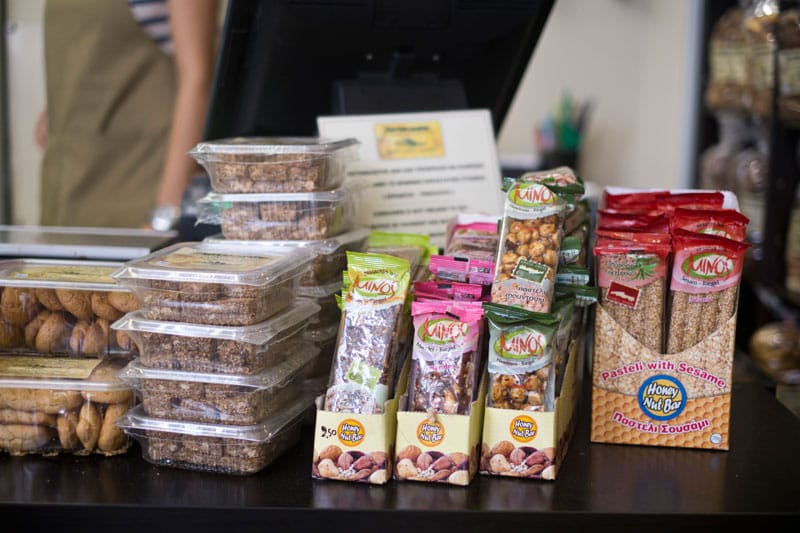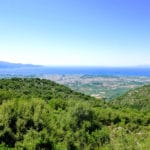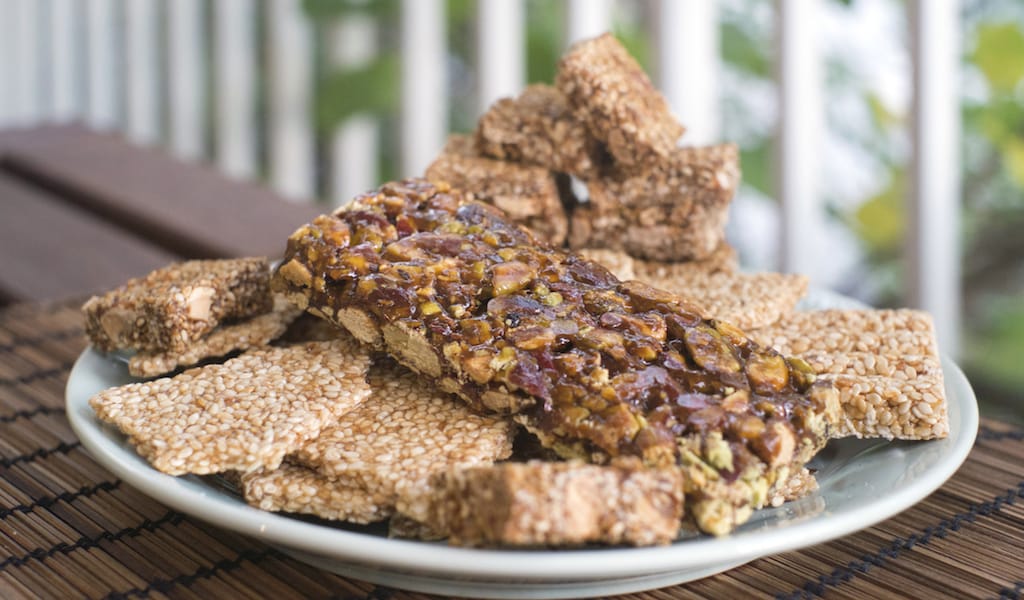Editor’s note: It’s Sweets Week here at Culinary Backstreets, and for our third installment, our Athens correspondent writes about a truly ancient treat that can still be found everywhere in Greece today.
The origins of pasteli, a honey and sesame bar sold everywhere in Greece from supermarkets to delis to bakeries, can be traced back to Greek and Roman antiquity. Athenaeus of Naucratis, in his Deipnosophistae (“The Dinner Experts”), written in the 3rd century A.D., mentions it many times, and references to pasteli can be found all over ancient Greek and Byzantine texts.
The recipe for these rectangular bars of sesame and honey is quite simple but varies from region to region. In the Peloponnese, honey is heated in a special pan. Once it starts boiling, its bubbly froth is slowly removed until the honey reaches a more solid state. The sesame is then added slowly while the mixture is constantly stirred until it becomes homogeneous. It is then spread onto a marble surface or a special pan that has been oiled with sweet wine or almond oil. Once dried, the pasteli is cut into pieces.
The endless variations come from the proportions of honey and sesame: More honey makes for a chewier sweet, more sesame yields a crunchier result. Other kinds might include sugar, almonds, pistachios or dried fruit.

A lot of Greeks who grew up in recent decades associate pasteli with the crunchy, rock-hard commercial versions they tried as kids. The sesame could be overwhelming, and for many it was an acquired taste. Traditional pasteli is actually nothing like that, and furthermore, it’s rich in vitamin E, calcium and iron. Unsurprisingly, many companies are now trying to market pasteli as a healthy alternative to energy bars. To determine which kinds are the best, we taste-tested most of the commercially sold pasteli available at supermarkets and delis. These are our recommendations:
We loved the pasteli made by the Lambou family in Kalamata. They make many different versions, including a very crunchy sesame-rich one, but they are most famous for their soft, satisfyingly chewy, honey-rich pasteli with no added sugar or preservatives. There is so much honey in it that your fingers will remain sticky long after you’ve gobbled it up.
From the island of Rhodes comes a fantastic local pasteli called melekouni, which is one of the versions being marketed as an energy bar alternative. Traditionally a gift at weddings and christenings, this version is fragrant with lemon, almonds, orange peel and spices. Melekouni remains unknown to most Greeks, but we’re sure it’ll soon get the attention it deserves among the up-and-coming local Greek delicacies.
Last but not least, there is Pasteleion, a brand that started as a homemade hybrid between a pasteli and an energy bar in the kitchen of Mrs. Malamo Miloyannaki, in Chania, Crete. Her pasteli is packed with almonds, honey and dried fruit. Sesame makes up only 7 percent of the recipe, and the honey is not boiled. This one resembles a good energy bar and has a strong flavor of dried fruit. Though short on the traditional sesame taste of pasteli, this one – like the other two versions we tried – still seemed to evoke an earlier time. Athenaeus of Naucratis would approve.
 September 21, 2016 CB on the Road
September 21, 2016 CB on the Road
All around Messinia lie endless fields of olive trees, their silvery leaves shining […] Posted in Athens November 11, 2015 The Salepçi of Sütçüler
November 11, 2015 The Salepçi of Sütçüler
By the name of the place, you’d expect the Sütçüler (“Milkmen” in English) district near […] Posted in Istanbul April 1, 2024 Pastiera
April 1, 2024 Pastiera
Like the Proustian madeleine, sweets can stir up all kinds of feelings in the minds of […] Posted in Naples
Published on November 19, 2014
Related stories
September 21, 2016
AthensAll around Messinia lie endless fields of olive trees, their silvery leaves shining everywhere you look. This region in the southwestern part of the Peloponnese has been known for its fertile land since ancient times. Some of the best olive oil in the world comes from here. The capital, largest city and central port of…
November 11, 2015
IstanbulBy the name of the place, you’d expect the Sütçüler (“Milkmen” in English) district near Isparta in southern Turkey to be a dairyland paradise, thick on the ground with men carrying buckets sloshing fresh milk, cheese wheels stacked in cool dark sheds, verdant hills freckled with cows. But there are no milkmen in Sütçüler, at…
April 1, 2024
NaplesLike the Proustian madeleine, sweets can stir up all kinds of feelings in the minds of those who eat them. In Naples, struffoli (small, round doughnuts glazed with honey) and cassata (sponge cake with ricotta and candied fruit) speak of Christmas, while chiacchiere (sugar-dusted fritters) and sanguinaccio (literally “blood pudding,” but actually made of chocolate)…

















































































